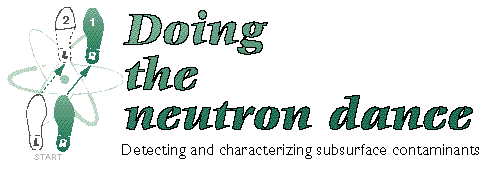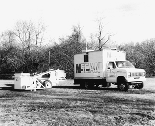


Westinghouse Electric Corp. of Pittsburgh, Pennsylvania is in its third decade of using a technology called Prompt Gamma Neutron Activation Analysis. More than twenty years ago, the Federal Aviation Administration began using PGNAA to detect explosives in luggage. When a proposal in response to a Program Research and Development Announcement issued by the Morgantown Energy Technology Center was accepted, however, Westinghouse began adapting the technology to detect the type and amount of contaminants in concrete floors at Department of Energy facilities. PGNAA works by sending neutrons below the surface. When the neutrons meet a contaminant, they instantly produce high energy "prompt" gamma rays that can be measured when they return to the surface. The energy of the gamma rays is specific to the type of substance from which they were emitted, making a unique energy signature.
 The Scientific Ecology Group, Inc., a wholly owned subsidiary of Westinghouse, is converting the trademarked technology for field use in its N-SCAN system. Each second, an electronic neutron generator in the N-SCAN field survey vehicle sends 200 to 2,000 pulses of neutrons down into the site being tested. At predetermined times, a specially designed detector measures the gamma rays produced. A high-speed circuit determines when the neutron generator should pulse and when the gamma ray detector should make readings. Up to eight, time-delayed gamma ray measurements can be made between neutron pulses. The field survey vehicle, a mid-sized Bobcat loader, communicates the measurement values to computer analysis equipment in the N-SCAN data van up to half a mile away.
The Scientific Ecology Group, Inc., a wholly owned subsidiary of Westinghouse, is converting the trademarked technology for field use in its N-SCAN system. Each second, an electronic neutron generator in the N-SCAN field survey vehicle sends 200 to 2,000 pulses of neutrons down into the site being tested. At predetermined times, a specially designed detector measures the gamma rays produced. A high-speed circuit determines when the neutron generator should pulse and when the gamma ray detector should make readings. Up to eight, time-delayed gamma ray measurements can be made between neutron pulses. The field survey vehicle, a mid-sized Bobcat loader, communicates the measurement values to computer analysis equipment in the N-SCAN data van up to half a mile away.
According to Tom Congedo of Westinghouse, for this application an electronic neutron generator is superior to previously used radioisotope neutron sources, which emit gamma rays and produce neutrons of much lower energy. In addition, unlike an electronic neutron generator, the neutron and gamma radiation from radioisotopes cannot be turned off, creating a storage and pulse-timing problem.
Typically, non-invasive technologies are only effective at the surface, but N-SCAN can measure contaminants volumetrically. While neutrons can travel deep into the ground, the limiting factor is the depth from which emitted gamma rays can be detected. Another benefit of N-SCAN is that, since it's an in-situ characterization and detection technology, it reduces exposure risk to workers who would otherwise have to take samples, transport them to labs for testing, and safely dispose of them.
Since 1992, Westinghouse has been successfully demonstrating a laboratory prototype of N-SCAN to detect a number of elements. Current efforts are focusing on detecting seven contaminants in concrete floors. Ultimately, N-SCAN will be tested at a DOE facility.
Congedo said a big challenge for Westinghouse is to make the technology more sensitive to trace and near-trace amounts of contaminants below the surface. By modifying the system to detect such extremely low levels in-situ, "we are going after the hardest application," he commented.